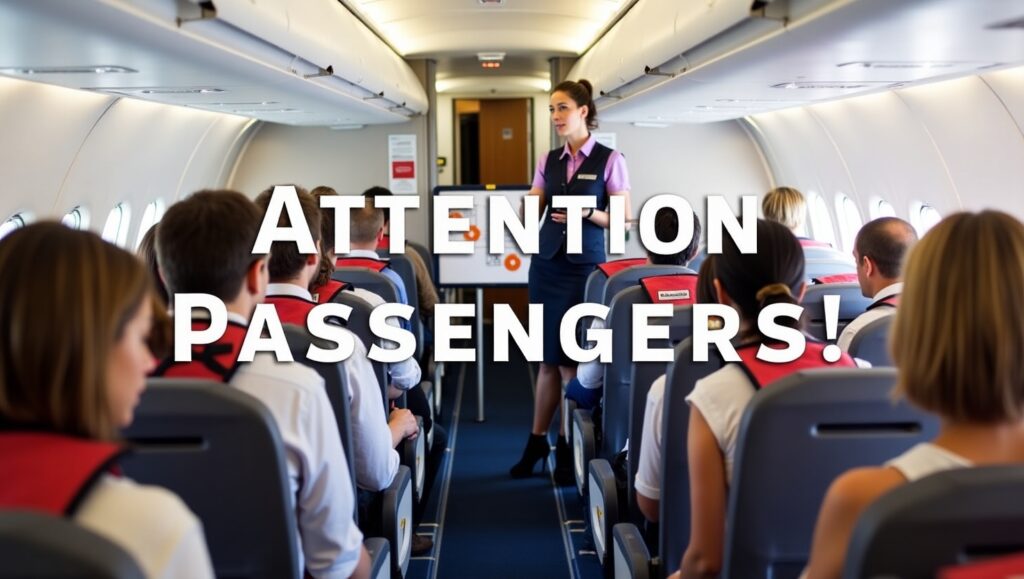Welcome aboard! Before we take off, let’s explore something that often gets overlooked but plays a crucial role in aviation safety—the pre-flight safety briefing. While many passengers treat it as routine or tune it out, this briefing is one of the most important parts of your journey. Here’s why you should pay attention every time you fly.
✈️ Why Safety Briefings Matter
Air travel is one of the safest modes of transportation, thanks to strict international safety standards, well-trained crew members, and advanced aircraft technology. One of the foundational elements of this safety system is the cabin safety briefing—a short but essential presentation delivered by flight attendants before takeoff.
These briefings are not just formalities. They are carefully designed to inform passengers about what to do in the event of an emergency. From explaining how to use seatbelts and oxygen masks to identifying emergency exits, the briefing ensures every passenger is prepared to respond calmly and confidently, even in unexpected situations.
At Buddha Air, a leading domestic airline in Nepal, we prioritize safety above all. Our cabin crew members undergo continuous training to ensure that they deliver clear, accurate, and up-to-date safety information on every flight.
🚨 What Makes the Safety Briefing So Important?
Each safety briefing covers critical procedures designed to protect passengers in case of an emergency. Here’s what it typically includes:
- Seatbelt Instructions: You’ll learn how to fasten, adjust, and unfasten your seatbelt correctly. This is vital during takeoff, landing, and turbulence.
- Oxygen Mask Usage: In case of a sudden loss of cabin pressure, passengers are shown how to use oxygen masks—always put yours on before helping others.
- Life Jacket Demonstration: On flights that cross bodies of water, passengers are instructed on how to locate and wear life jackets for emergency water landings.
- Emergency Exits: The crew highlights the location and operation of emergency exits. Knowing your nearest exit is essential in an evacuation.
- Safety Cards: These visual guides located in your seat pocket offer step-by-step emergency procedures. Passengers are encouraged to review them before takeoff.
These components are standard on all commercial flights, and even more vital when flying in Nepal’s challenging terrain and unpredictable weather conditions.
👩✈️ Cabin Crew: Your Onboard Safety Experts
Cabin crew members do more than serve meals and assist with luggage—they are certified safety professionals trained to handle emergencies with speed and precision. Before every flight, they attend detailed safety briefings tailored to the flight route, weather conditions, and aircraft type.
At Buddha Air, our flight attendants participate in regular training programs to update their skills and knowledge on the latest safety procedures. This ensures they are fully prepared to handle any scenario and provide our passengers with a safe, comfortable flying experience.
🏔️ Safety Briefings Are Even More Critical in Nepal
Operating in a country like Nepal, with its mountainous terrain and variable weather, adds layers of complexity to air travel. Safety briefings are specially adapted to account for:
- Rapid altitude changes
- Limited visibility
- Short-runway airports
Buddha Air incorporates these unique conditions into every safety announcement, helping passengers feel more secure and informed. Our goal is to ensure every traveller, regardless of experience level, understands how to stay safe on board.
👪 Passengers with Special Needs
We understand that some passengers may require extra support. Our cabin crew offers personalized assistance for families with young children, elderly travellers, and those with disabilities. If you need clarification or have questions during the safety briefing, please ask—your safety is our priority.
🛡️ A Simple Action That Saves Lives
The pre-flight safety briefing is more than a formality—it can save lives. Emergencies are rare, but being prepared is the best defense. Listening to the safety instructions takes just a few minutes but could make all the difference in a critical moment.
So, the next time you hear “Ladies and Gentlemen, please direct your attention to the cabin crew,” don’t tune out. Tune in.
✅ Key Takeaways
- Always pay attention to the safety briefing, even if you’re a frequent flyer.
- Review the safety card to refresh your knowledge.
- Ask questions if anything is unclear.
- Stay calm and informed—knowledge is your best tool in an emergency.
At Buddha Air, we believe that safe skies begin with informed passengers. Thank you for choosing to fly with us, and remember: every briefing brings you one step closer to a safer journey.

